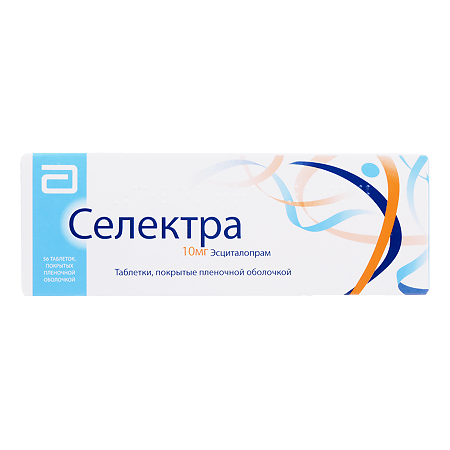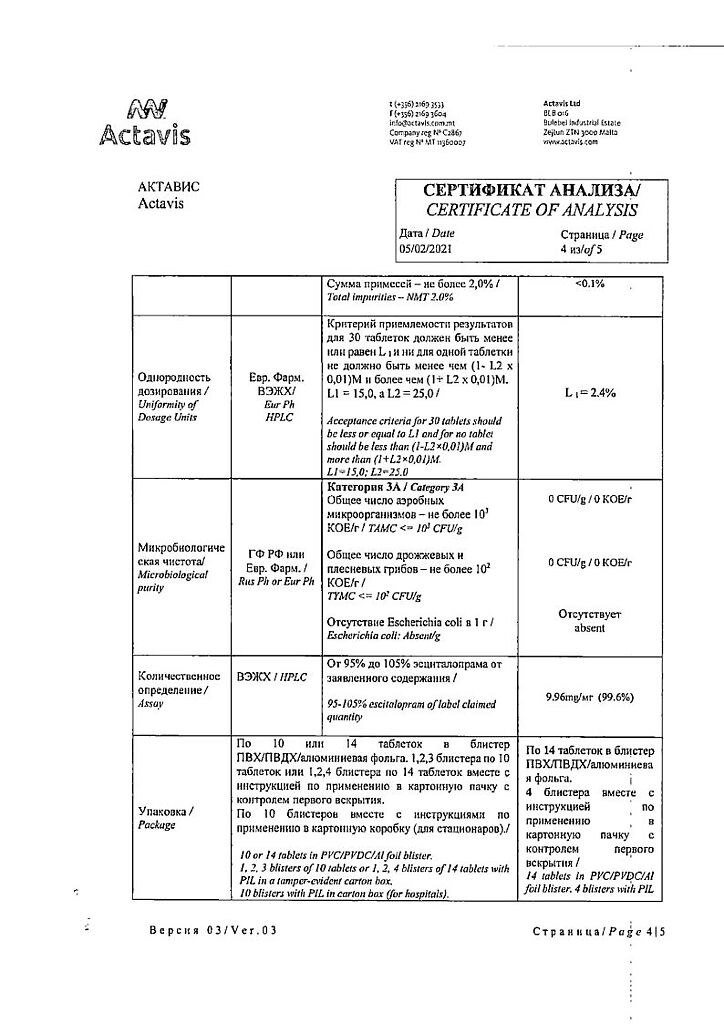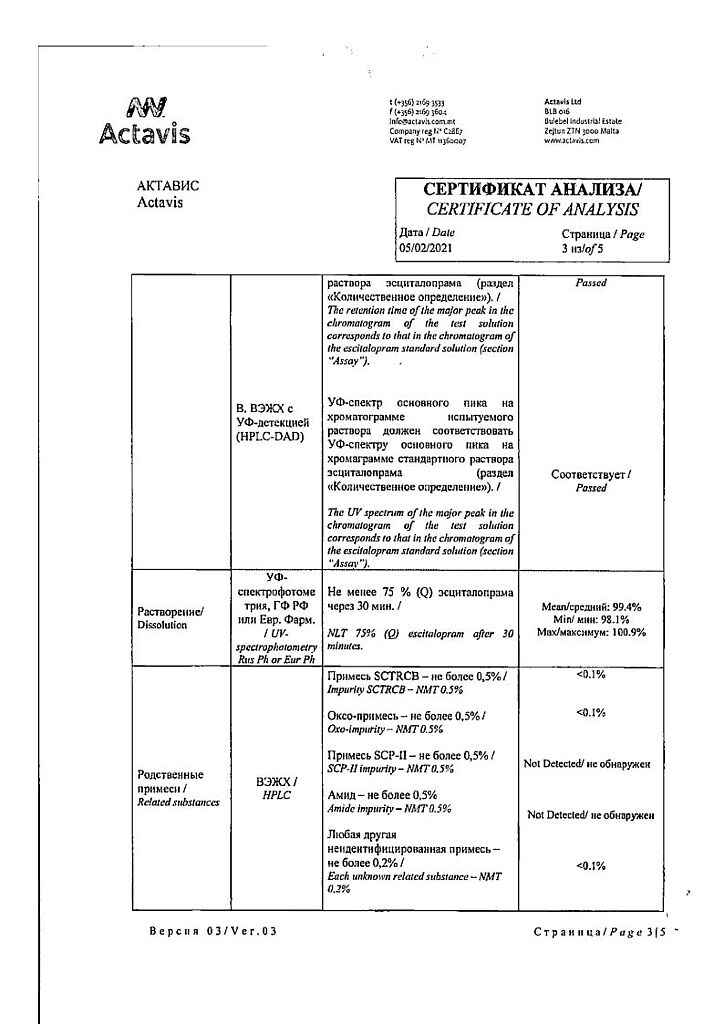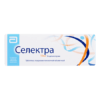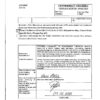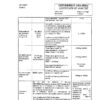No products in the cart.
Selectra, 10 mg 56 pcs.
€1.00
Out of stock
(E-mail when Stock is available)
Description
Antidepressant.
Selectively inhibits serotonin reuptake; increases the concentration of the neurotransmitter in the synaptic cleft, enhances and prolongs the effect of serotonin on postsynaptic receptors.
Escitalopram almost does not bind with serotonin (5-HT), dopamine (D1 and D2) receptors, α-adreno, m-cholinoreceptors, and benzodiazepine and opioid receptors.
Antidepressant effect usually develops 2-4 weeks after treatment start. Maximal therapeutic effect of panic disorder treatment is reached approximately 3 months after the treatment start.
Indications
Indications
Active ingredient
Active ingredient
Composition
Composition
1 tablet contains:
The active ingredients:
escitalopram oxalate – 12.78 mg, which corresponds to the content of escitalopram 10 mg;
Associates:
Prosolv SMCC90/HD90 – 147.42 mg (microcrystalline cellulose – 144.47 mg, silicon dioxide – 2.95 mg),
croscarmellose sodium – 9 mg,
talc – 9 mg,
magnesium stearate – 1.8 mg.
Composition of the film coating:
Opadry White (Opadry 03F28446 White) ~ 5.4 mg:
Hypromellose 6cP – 3.29 mg,
Titanium dioxide – 1.31 mg,
Macrogol 6000 – 0.8 mg.
How to take, the dosage
How to take, the dosage
The drug is administered adults and children over 15 years once daily orally, regardless of meals.
In depressive disorders 10 mg once daily is prescribed. Depending on the individual reaction of the patient, the dose may be increased to a maximum of 20 mg/day.
The antidepressant effect usually develops 2-4 weeks after the start of treatment. After symptoms of depression have disappeared, it is necessary to continue therapy for at least another 6 months to consolidate the effect obtained.
In panic disorder with/without agoraphobia during the first week of treatment, a dose of 5 mg/day is recommended, which is then increased to 10 mg/day. Depending on the individual reaction of the patient, the dose may be increased to a maximum of 20 mg/day.
The maximum therapeutic effect is achieved about 3 months after the start of treatment. Therapy lasts for several months.
Elderly patients (over 65 years of age) are recommended to receive half the normally recommended dose (i.e., only 5 mg/day) and a lower maximum dose (10 mg/day).
In mild to moderate renal failure, no dose adjustment is required. Patients with severe renal failure (CKD below 30 ml/min) should be prescribed the drug from the lowest therapeutic dose, gradually increasing them with regard to tolerability and effectiveness of the drug.
In case of disordered liver function, the recommended starting dose for the first two weeks of treatment is 5 mg/day. Depending on the patient’s individual response, the dose may be increased to 10 mg/day.
For patients with weak CYP 2C19 isoenzyme activity, the recommended initial dose for the first two weeks of treatment is 5 mg/day. Depending on the individual response of the patient, the dose may be increased to 10 mg/day.
When discontinuing treatment with the drug, the dose should be gradually reduced over 1-2 weeks to avoid the onset of withdrawal syndrome.
Interaction
Interaction
Serious adverse reactions may occur when taking Selectra concomitantly with MAO inhibitors or when taking MAO inhibitors in patients who have stopped taking the drug shortly before. Serotonin syndrome may develop in such cases.
Escitalopram should not be prescribed concomitantly with MAO inhibitors. Excitalopram may be prescribed 14 days after stopping treatment with irreversible MAO inhibitors and at least 1 day after stopping therapy with the reversible type A MAO inhibitor moclobemide. At least 7 days should pass after stopping escitalopram before starting treatment with non-selective MAOI inhibitors.
The co-administration with serotonergic drugs (e.g., tramadol, sumatriptan and other triptans) may lead to serotonin syndrome.
Selectra may decrease the seizure threshold. Caution is required when concomitantly prescribed with other drugs that lower the seizure threshold (tricyclic antidepressants, other SSRIs, neuroleptics (phenothiazines, thioxanthene and butyrophenone derivatives), mefloquine and tramadol).
Escitalopram enhances the pharmacological effects of tryptophan (enhancement of serotonergic effects) and toxic effects of drugs lithium.
The simultaneous administration of escitalopram and drugs containing wortwort (Hypericum perforatum) may increase the number of side effects.
A clotting disorder may occur with concomitant administration of escitalopram with oral anticoagulants and other drugs that affect blood clotting/(e.g., atypical antipsychotics and phenothiazines, most tricyclic antidepressants, acetylsalicylic acid and NSAIDs, ticlopidine and dipyridamole). In such cases, it is necessary to monitor blood clotting parameters.
Escitalopram has no pharmacodynamic or pharmacokinetic interaction with ethanol. However, as with other psychotropic drugs, concomitant use of escitalopram and alcohol is not recommended.
Influence of other drugs on the pharmacokinetics of escitalopram
The co-administration with drugs that inhibit CYP2C19 may increase the plasma concentration of escitalopram. Caution should be exercised when concomitant use of escitalopram with similar drugs such as omeprazole. It may be necessary to reduce the dose of escitalopram.
With caution, high doses of escitalopram should be prescribed concomitantly with cimetidine, which is a strong inhibitor of the CYP2D6, CYP3A4 and CYP1A2 isoenzymes.
Influence of escitalopram on the pharmacokinetics of other drugs
Escitalopram is an inhibitor of CYP2D6 isoenzyme. Caution should be exercised when concomitant administration of escitalopram and drugs that are metabolized with this isoenzyme and have a low therapeutic index, such as flecainide, propafenone and metoprolol (in cases of use in heart failure) or drugs mainly metabolized by CYP2D6 and acting on CNS, such as antidepressants – desipramine, clomipramine, nortriptyline or antipsychotic drugs – risperidone, thioridazine, haloperidol. In these cases a dose adjustment may be required, because the plasma concentration of escitalopram increases.
The simultaneous administration of escitalopram and desipramine or metoprolol leads to a twofold increase in concentrations of the latter two drugs, which should be considered when choosing doses.
Escitalopram may slightly inhibit the CYP2C19 isoenzyme. Therefore, caution is recommended when concomitant use of escitalopram and medications metabolized by CYP2C19.
Special Instructions
Special Instructions
Some patients with panic disorder may experience an increase in anxiety at the start of SSRI treatment. This paradoxical reaction usually disappears within two weeks of treatment. To reduce the likelihood of an anxiogenic effect, it is recommended that the drug be used in a low starting dose.
The drug should be discontinued if seizures develop. Use in patients with uncontrolled epilepsy is not recommended; in controlled seizures, close monitoring is necessary. If seizure frequency increases, SSRIs, including escitalopram, should be discontinued.
Escitalopram should be used with caution in patients with a history of mania/hypomania. If a manic state develops, escitalopram should be withdrawn.
In patients with diabetes mellitus, treatment with escitalopram may alter blood glucose levels (both hypoglycemia and hyperglycemia are possible). Therefore, adjustment of insulin doses and/or oral hypoglycemic drugs may be required.
The risk of suicide is intrinsic to depression and may persist until a significant improvement has occurred spontaneously or as a result of ongoing therapy. Close monitoring of patients on antidepressant treatment is necessary, especially at the beginning of treatment, because of the potential for clinical deterioration and/or the appearance of suicidal ideation (thoughts and behavior). This precaution should also be observed when treating other psychiatric disorders because of the possibility of simultaneous development of depression.
In some cases, treatment with SSRI antidepressants has been shown to increase the risk of suicidal thoughts and behaviors in children, adolescents and young adults younger than 24 years compared to placebo.
Hyponatremia, possibly related to impaired ADH secretion, is rare with escitalopram and usually disappears with discontinuation of therapy. Caution should be exercised when prescribing escitalopram and other SSRIs in individuals at risk for hyponatremia: the elderly, patients with cirrhosis of the liver, and those taking medications that can cause hyponatremia.
The use of escitalopram may cause subcutaneous hemorrhages (ecchymoses and purpura). It is necessary to use escitalopram with caution in patients who are prone to bleeding, as well as those who take oral anticoagulants and other drugs affecting blood clotting.
Because clinical experience with concomitant use of escitalopram and electroconvulsive therapy is limited, caution should be exercised in such cases.
The combination of escitalopram and MAO type A inhibitors is not recommended because of the risk of serotonin syndrome.
Patients taking escitalopram and other SSRIs concomitantly with serotonergic drugs may, in rare cases, develop serotonin syndrome. Caution should be exercised when using escitalopram concomitantly with drugs with serotonergic effects. The combination of symptoms such as agitation, tremor, myoclonus, hyperthermia, may indicate the development of serotonin syndrome. If this occurs, SSRIs and serotoninergic medications should be discontinued immediately and symptomatic treatment administered.
Influence on driving and operating machinery
Patients should avoid potentially hazardous activities requiring high-speed psychomotor reactions, such as driving or operating machinery, during treatment with the drug.
Synopsis
Synopsis
Contraindications
Contraindications
– concomitant use with MAO inhibitors;
– concomitant use of pimozide;
– childhood and adolescence (under 18 years);
Side effects
Side effects
Side effects occur most frequently in 1 or 2 weeks of treatment, then usually become less intense and occur less frequently with continued therapy.
CNS side effects: Dizziness, weakness, insomnia or somnolence, seizures, tremors, motor disturbances, serotonin syndrome (agitation, tremors, myoclonus, hyperthermia), hallucinations, manic disorders, confusion, agitation, anxiety, depersonalization, panic attacks, increased irritability, visual disturbances.
From the digestive system: Nausea, vomiting, dry mouth, taste disorders, decreased appetite, diarrhea, constipation.
Cardiovascular system side: orthostatic hypotension.
From the endocrine system: decreased secretion of ADH, galactorrhea.
From the genitourinary system: decreased libido, impotence, impaired ejaculation, anorgasmia (in women), urinary retention.
Dermatological reactions: skin rash, itching, ecchymosis, purpura.
Allergic reactions:angioneurotic edema,anaphylactic reactions.
From the laboratory side: hyponatremia, changes in laboratory indicators of liver function.
Others: Elevated sweating, hyperthermia, sinusitis, arthralgia, myalgia.
In addition, after long-term use, abrupt discontinuation of Selectra therapy in some patients may lead to withdrawal syndrome. Adverse reactions such as dizziness, headaches, and nausea may occur with abrupt discontinuation of escitalopram, but are mild in severity and of limited duration.
Overdose
Overdose
Symptoms:dizziness, tremor, agitation, drowsiness, confusion, seizures, tachycardia, ECG changes (change of ST segment, T tooth, widening of QRS complex, QT interval prolongation), arrhythmias, respiratory depression, vomiting, rhabdomyolysis, metabolic acidosis, hypokalemia, very rare – acute renal failure.
Treatment: symptomatic and supportive: gastric lavage, adequate oxygenation. Monitoring of cardiovascular and respiratory system function. There is no specific antidote.
Pregnancy use
Pregnancy use
Similarities
Similarities
Additional information
| Shelf life | 1 year |
|---|---|
| Conditions of storage | The drug should be kept out of reach of children at a temperature not exceeding 25 ° C. |
| Manufacturer | Actavis Ltd, Malta |
| Medication form | pills |
| Brand | Actavis Ltd |
Related products
Buy Selectra, 10 mg 56 pcs. with delivery to USA, UK, Europe and over 120 other countries.

